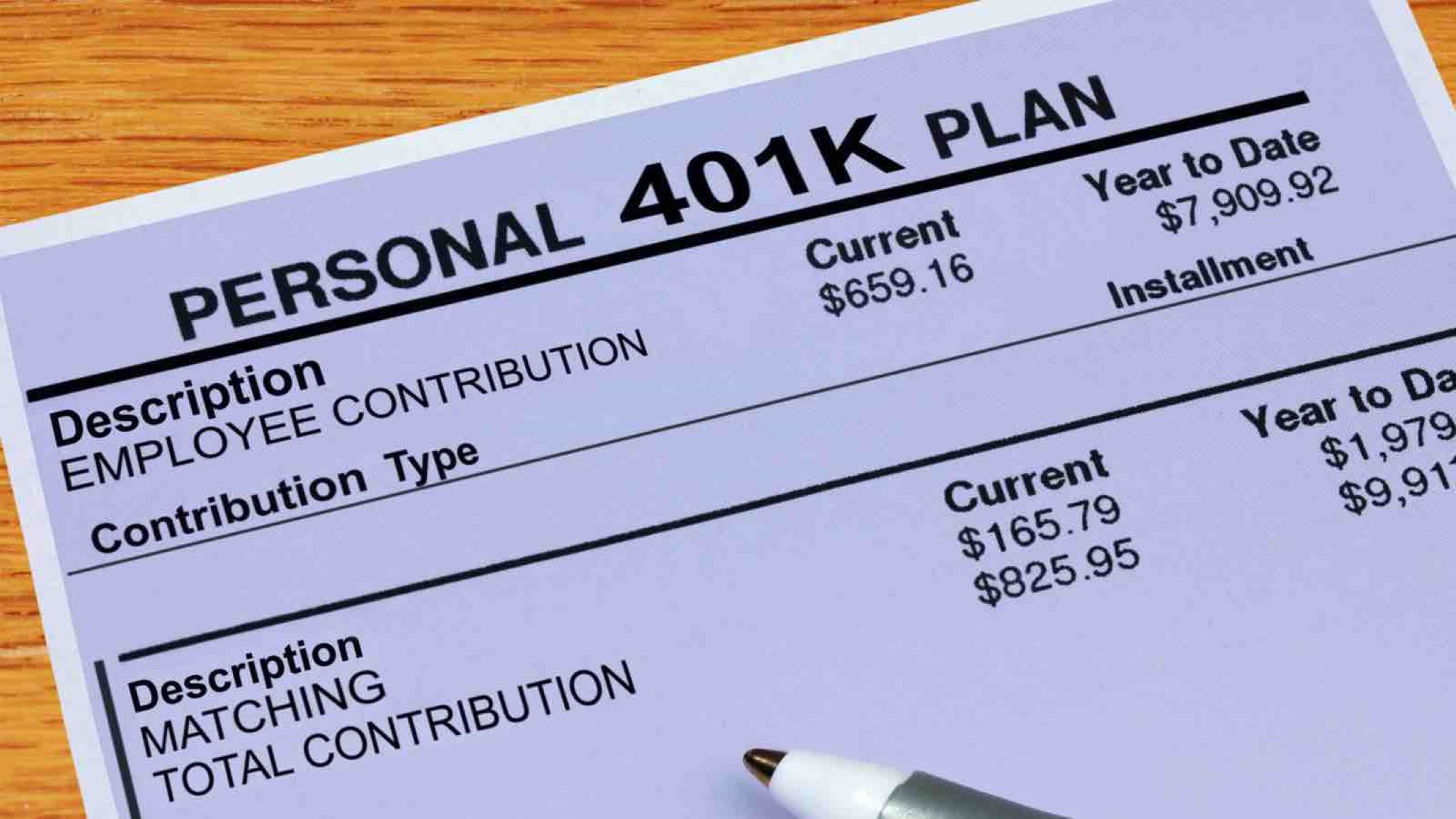

Finance
How To Report Excess 401K Contribution
Modified: February 21, 2024
Learn how to report excess 401K contribution in this comprehensive finance guide. Keep your finances in check and avoid IRS penalties.
(Many of the links in this article redirect to a specific reviewed product. Your purchase of these products through affiliate links helps to generate commission for LiveWell, at no extra cost. Learn more)
Table of Contents
Introduction
Welcome to our comprehensive guide on how to report excess 401K contributions. Understanding 401K contributions and how they work is crucial for individuals planning for a secure financial future. However, it is possible to mistakenly contribute more than the allowable limit to your 401K plan, which can have unintended consequences.
In this article, we will explain what 401K contributions are and how they are regulated. We will also guide you on how to recognize when you have made excess 401K contributions and provide step-by-step instructions on how to report and correct these contributions. Additionally, we will share some valuable tips on how to avoid making excess 401K contributions in the future. By the end of this guide, you will be equipped with the knowledge and tools you need to navigate this complex financial situation effectively.
It’s important to note that while we strive to provide accurate and up-to-date information, this article is not intended to serve as legal or financial advice. If you have specific questions or concerns about your personal financial situation, it is best to consult with a qualified financial advisor or tax professional.
Understanding 401K Contributions
Before we delve into the specifics of reporting excess 401K contributions, let’s first understand what a 401K contribution is and how it works. A 401K is a retirement savings plan offered by employers to their employees, providing them with an opportunity to save and invest for their future.
Contributions to a 401K plan are typically deducted from an employee’s paycheck before taxes are applied, which means that the contributions are made on a pre-tax basis. This has the advantage of reducing an individual’s current taxable income, effectively lowering their overall tax liability.
While the Internal Revenue Service (IRS) sets limits on how much an individual can contribute to their 401K plan each year, these limits may vary depending on various factors, including age and income level.
For the year 2022, the maximum elective deferral contribution limit for employees under the age of 50 is $20,500. If you are 50 years of age or older, you can take advantage of catch-up contributions, allowing you to contribute an additional $6,500, for a total maximum contribution of $27,000.
It’s essential to be aware of these contribution limits to avoid inadvertently overcontributing to your 401K plan and potentially facing penalties and other consequences.
While employers may have their own specific policies and rules regarding 401K contributions, it’s important to remember that the IRS governs the overall guidelines and regulations for these plans. Familiarizing yourself with the IRS rules and regulations will help you stay compliant and make informed decisions when it comes to your 401K contributions.
Now that we have a basic understanding of 401K contributions, let’s move on to the next section, where we will explore how to recognize when you’ve made excess 401K contributions.
Recognizing Excess 401K Contributions
Recognizing when you have made excess 401K contributions is crucial to avoid potential penalties and address the situation promptly. Here are some key indicators that can help you identify if you’ve made excess contributions to your 401K plan:
- Monitoring your contributions: Keep a close eye on your 401K contributions throughout the year, especially if you have multiple sources of income or contribute to multiple retirement plans. Regularly review your paycheck deductions and ensure that you are not exceeding the maximum contribution limits set by the IRS.
- Employer matching contributions: Many employers offer matching contributions to their employees’ 401K plans. While employer match is a valuable benefit, it’s important to consider if your contributions, along with the employer match, exceed the annual contribution limits. If they do, you may have made excess contributions.
- Change in employment: If you switch jobs during the year, it’s crucial to consider the contributions you made to your previous employer’s 401K plan and ensure that they are accounted for when determining your total contributions for the year. Failure to account for these contributions can lead to excess contributions.
- IRS Form W-2: Your employer will provide you with an IRS Form W-2 at the end of the year, which outlines your total income and the amount of pre-tax contributions made to your 401K plan. Review this form carefully to verify that your contributions fall within the allowable limits. Any excess contributions will be indicated on the form.
If you realize that you have made excess contributions to your 401K plan, it’s important to take immediate action to rectify the situation to minimize any negative financial implications. In the next section, we will guide you on how to report excess 401K contributions accurately.
Reporting Excess 401K Contributions
If you have determined that you have made excess contributions to your 401K plan, it is crucial to report them accurately to the IRS. Reporting excess 401K contributions involves the following steps:
- Obtain the necessary forms: To report excess 401K contributions, you will need to fill out IRS Form 1099-R. This form captures information related to distributions from retirement accounts, including any excess contributions.
- Enter the excess contribution amount: On Form 1099-R, you will need to indicate the amount of excess contributions made to your 401K plan. This information can usually be found on your Form W-2 provided by your employer.
- Calculate the earnings: In addition to reporting the excess contributions, you must also calculate the earnings associated with those excess contributions. This is because any earnings generated by the excess contributions are subject to income tax in the year they were earned.
- Report the excess contributions on your tax return: When filing your tax return, report the excess contributions and the associated earnings on Form 1040. This will ensure that the IRS is aware of the excess contributions and can adjust your tax liability accordingly.
- Consult with a tax professional: Reporting excess 401K contributions can be complex, and it is advisable to consult with a tax professional or financial advisor. They can guide you through the process, ensure accurate reporting, and help you navigate any potential tax implications.
Once you have accurately reported the excess contributions, the IRS will make the necessary adjustments to your tax return, ensuring compliance with the contribution limits. It is important to note that excess contributions are subject to a 6% excise tax unless they are corrected within the specified timeframe.
Next, we will discuss the steps you can take to correct excess 401K contributions and minimize any potential penalties or tax implications.
Correcting Excess 401K Contributions
If you discover that you have made excess contributions to your 401K plan, it is crucial to correct the situation promptly to mitigate any penalties or tax implications. Here are the steps you can take to correct excess 401K contributions:
- Contact your plan administrator: Reach out to your 401K plan administrator as soon as possible to notify them of the excess contributions. They will guide you through the process and provide specific instructions on how to correct the excess contributions.
- Request a return of excess contributions: The plan administrator will assist you in initiating a return of the excess contributions from your 401K account. Depending on the plan’s rules and regulations, you may be required to fill out additional forms or provide supporting documentation.
- Withdraw the excess contributions: Once approved, the plan administrator will arrange for the excess contributions to be withdrawn from your 401K account. This withdrawal is typically treated as taxable income for the year in which the excess contributions were made.
- Address the associated earnings: In addition to withdrawing the excess contributions, you will also need to address any earnings associated with those excess contributions. These earnings are subject to income tax in the year they were earned. You may need to consult with a tax professional to ensure accurate reporting.
- File an amended tax return if necessary: If you have already filed your tax return for the year in which the excess contributions were made, you may need to file an amended tax return to reflect the corrected contribution amounts. This will ensure that your tax liability is adjusted accordingly.
It’s important to note that each 401K plan may have its own specific rules and procedures for correcting excess contributions. Therefore, it is advisable to follow the instructions provided by your plan administrator to ensure compliance with the plan’s requirements.
By taking these steps to correct excess 401K contributions promptly, you can minimize any potential penalties and ensure that your retirement savings remain on track. However, prevention is always better than correction. Let’s explore some tips on how to avoid making excess 401K contributions in the future.
Avoiding Excess 401K Contributions in the Future
Preventing excess 401K contributions is essential for maintaining compliance with IRS regulations and avoiding unnecessary financial complications. Here are some tips to help you avoid making excess contributions to your 401K plan in the future:
- Understand the contribution limits: Familiarize yourself with the annual contribution limits set by the IRS for 401K plans. For 2022, the maximum elective deferral contribution limit is $20,500 for individuals under the age of 50. Those aged 50 or older can contribute an additional catch-up amount of $6,500, bringing the total to $27,000.
- Coordinate contributions across multiple employers: If you have multiple employers or work part-time jobs, ensure that your total contributions from all employers stay within the annual limits. Track your contributions throughout the year to avoid exceeding the allowable maximum.
- Monitor automatic contributions: If you have set up automatic contributions to your 401K plan, regularly review and adjust them to ensure they remain within the contribution limits. Life changes, such as salary increases or changes in employment status, may necessitate adjustments to your contribution amounts.
- Review employer matching policies: Understand your employer’s matching policies and contribution limits. Ensure that your contributions, combined with the employer match, do not exceed the annual limits set by the IRS.
- Keep track of employment changes: If you change jobs during the year, make sure to account for contributions made to your previous employer’s 401K plan. Coordinate with your new employer’s HR department to ensure the accurate tracking of your contributions.
- Seek professional guidance: If you are unsure about your 401K contributions or have complex financial situations, consult with a financial advisor or tax professional. They can provide personalized guidance tailored to your circumstances and help you navigate the intricacies of retirement planning.
By being proactive and staying informed about contribution limits, monitoring contributions, and seeking professional guidance, you can avoid unintentionally making excess 401K contributions and maintain compliance with IRS regulations.
As we conclude this guide, it is important to remember that personal financial planning is a continuous process. Regularly reviewing and adjusting your contributions, staying updated on IRS regulations, and seeking professional advice can help you make informed decisions and achieve your long-term retirement goals.
In summary, understanding 401K contributions, recognizing excess contributions, accurately reporting them to the IRS, and taking prompt corrective action are essential for maintaining a healthy financial future. By implementing the tips provided and remaining vigilant, you can navigate your 401K contributions with confidence and avoid unnecessary complications down the road.
Conclusion
Managing your 401K contributions effectively is an important aspect of planning for a secure financial future. However, it is not uncommon to make mistakes, such as contributing more than the allowable limits. In this comprehensive guide, we have explored the process of reporting and correcting excess 401K contributions, as well as provided tips for avoiding them in the future.
Understanding the contribution limits set by the IRS and actively monitoring your contributions are key to preventing excess contributions. If you do find yourself in a situation where you have made excess contributions, it is vital to report them accurately to the IRS and promptly correct the mistake. Seeking professional guidance from a tax advisor or financial planner can provide valuable assistance throughout this process and ensure compliance with the complex regulations surrounding 401K plans.
Remember, maintaining compliance with IRS regulations and managing your 401K contributions responsibly will help you maximize your retirement savings and avoid unnecessary penalties or tax implications. Continuously educating yourself on the intricacies of 401K plans and seeking professional advice when needed are essential steps towards achieving your long-term financial goals.
By following the guidelines and tips outlined in this guide, you can confidently navigate the world of 401K contributions, protect your financial future, and work towards a comfortable retirement. Remember to stay informed, be proactive, and make informed decisions that align with your financial objectives.
Disclaimer: The information provided in this article is for educational purposes only and should not be considered financial or legal advice. It is always recommended to consult with a qualified professional regarding your specific circumstances.














